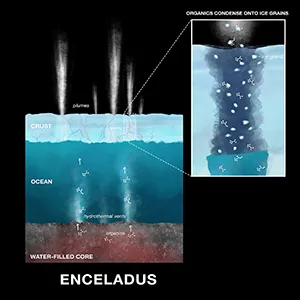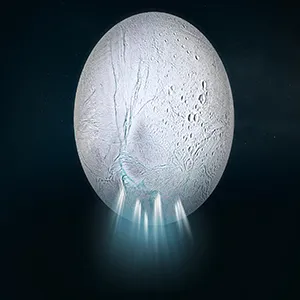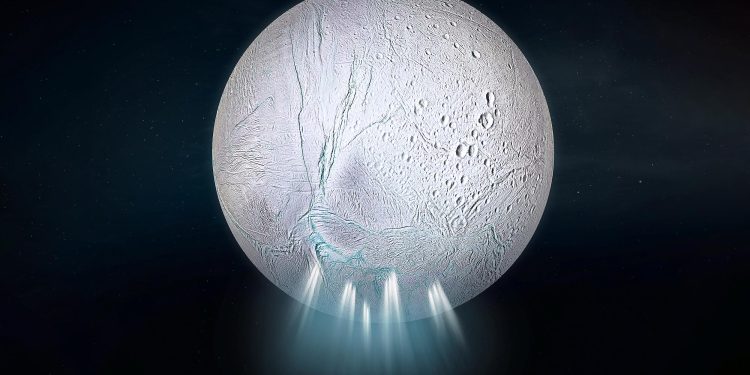NASA’s Cassini probe, which has explored Saturn and its moons for more than a decade, has made a new discovery. A recent peer-reviewed study discovered complex organic fragments in fresh ice grains from Saturn’s moon Enceladus, renewing hopes that this aquatic world harbors life in its oceans.
These grains were thrown from fractures near the South Pole and hit the spacecraft at about 18 km/s during a pass in October 2008.

This quick shot provided a more defined look at underground chemistry than previous, slower encounters.
Fresh ice grains from an ocean
Saturn’s E ring is a huge, faint ring of tiny ice particles that orbits well outside the planet’s main rings.
The oldest grains in Saturn’s E ring can spend years in space, where radiation scrambles the delicate molecules. The fresh grains ejected a few minutes earlier avoid this alteration and better reflect the ocean below.
Cassini’s mass spectrometer measured the ions produced when a grain shattered upon impact. At very high speeds, water molecules don’t clump together as much, so signals from organic materials stand out more clearly.
Lead author Nozair Khawaja of Freie Universität Berlin and the University of Stuttgart led the investigation and interpretation of the mass spectra.
“We are confident that these molecules come from Enceladus’ subterranean ocean, thereby enhancing its habitability potential,” Khawaja said.
This confidence is based on the discovery of the same families of molecules in the young grains of the plume and in the older grains of the E ring. It also relies on the laboratory matching of fragment models pointing to specific chemical groups.
Enceladus’ ice contains building blocks of life
The team reports fragments indicating aromatics, esters, ethers and alkenes, as well as tentative compounds containing nitrogen and oxygen. Simply put, they see building blocks that can power many reaction pathways.
These results do not claim life. They highlight active and diverse abiotic chemistry, the type of chemistry that, under the right conditions, can nourish biology.
The range of groups detected is important because it expands the menu of reactions that can occur when an ocean hits a rock. Each group opens different paths to more complex products.
Oceans lie beneath fresh ice
Tiny silica particles first signaled interactions between hot rocks and water beneath the ice. This proof comes from a 2015 Nature study that linked silica nanograins to hot, alkaline fluids flowing through a rock core.
Cassini then detected molecular hydrogen erupting with the plume gases. On Earth, this hydrogen comes from water reacting with rocks in hydrothermal systems, which can provide chemical energy to microbes.
These two lines of data, solid and gas, tell a coherent story. There is liquid water in contact with the rock and water-rock reactions are probably still occurring.

Elements of life on Enceladus
Phosphorus availability is a key habitability test. Sodium phosphates have been found in the ice grains of Enceladus, in concentrations that would far exceed levels typical of Earth’s oceans.
The six elements essential to life – carbon, hydrogen, nitrogen, oxygen, phosphorus and sulfur – make up almost all living matter on Earth. These elements are collectively known as CHNOPS.
With the presence of phosphorus, the catalog of known elements on Enceladus now covers most of CHNOPS, as well as salts and organic materials that can act as precursors. New organic compounds add functional groups used in pathways that produce larger molecules.
This is the field of astrobiology, which asks not only whether water is present, but also whether energy and useful chemistry can persist over time.
The answer for Enceladus continues to tend towards a yes on certain conditions, while remaining undecided on life.
Enceladus and Europa, Jupiter’s moon
Jupiter’s moon Europa also has an ocean hidden beneath an icy shell.
Unlike Enceladus, Europa’s surface shows signs of older ice movements, but does not have active jets that throw fresh material into space. This makes direct sampling more difficult.
The Europa Clipper mission will fly through Europa’s thin atmosphere and study its surface chemistry, but it will not have the same access to pristine ocean material that Cassini enjoyed at Enceladus.
This difference makes Enceladus a more direct target for testing questions about ocean chemistry and habitability.

The role of instrument behavior
Rapid impacts revealed organic matter that slower passages could not separate from water clumps. The behavior of this instrument is a practical lesson for future samplers who will fly over plumes or collect grains.
This approach also validates the value of single-grain spectra. A single grain may contain a distinct chemical mixture, and averaging multiple grains may eliminate important weak signals.
These lessons are already informing design studies. Higher rate sampling, wider mass ranges and complementary measurements of neutral gases will make the next look clearer.
Enceladus, organic matter and life
The European mission’s studies are evaluating a plan to directly sample the jets and land near the South Pole fractures. The concept is simple: hover over the spray, collect the fresh grains and analyze them on site.
The landing would allow instruments to test the chemistry of the surface gel where it falls and compare it with sampling of the plume. This would also allow longer observations of local temperature, texture and activity.
Even a zero result in biology would be valuable. If an ocean containing water, energy and complex organic matter shows no life, it would challenge current assumptions about how often life appears.
The study is published in the journal Natural astronomy.
—–
Do you like what you read? Subscribe to our newsletter for engaging articles, exclusive content and the latest updates.
Check us out on EarthSnap, a free app brought to you by Eric Ralls and Earth.com.
—–









